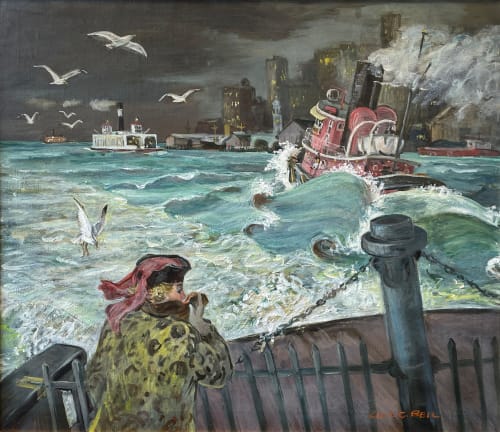New research and theories continue to animate the discussion of who came to the Americas first, from where and how. An ancient land bridge between Russia and Alaska may have brought the first peoples as the last ice age receded—or people may have arrived by sea from as yet undetermined locations.
The gallery continues: “Spurred by commissions by railway companies, both Charles Warren Eaton and John Fery produced canvases advertising the beauties of the American West. Looking the opposite direction, 20th-century female artists Jane Peterson and Pauline Palmer headed to Europe for better educational opportunities, where they discovered the marvels of Venetian canals and architecture. Yet other artists, such as John Marin and Gerrit Beneker were more than content to paint their coastal New England surroundings of Maine and Cape Cod, respectively. The trio of harbor views by Emile Gruppe, Antonio Jacobsen and Thomas Anshutz display the great degree of commerce occurring in East Coast ports as well as the Great Lakes. Gritty New York scenes by Cecil Bell on the Staten Island Ferry and a Depression-era playground scene on the East River’s banks by George Picken are offset by works executed by Sanford Robinson Gifford and Chiura Obata on fishing excursions.”
The busy but somewhat tranquil port of Rio de Janeiro contrasts with a busy, stormy scene of New York harbor 100 years later by Cecil Bell (1906-1970) in his painting Goodbye Manhattan, circa 1945. Bell was born in Seattle. He studied at the School of the Art Institute of Chicago and later with John Sloan at the Art Students League in New York. He lived on Staten Island and took the ferry to and from Manhattan, depicting the harbor and the city with the grittiness associated with Sloan and the Ashcan School.
Jane Peterson (1876-1965) was adventurous and traveled independently to study with Arthur Wesley Dow in New York, Frank Brangwyn in London and Venice, and with Joaquín Sorolla in Madrid. Living in Paris, she frequented the salons of Gertrude and Leo Stein. Her painting, Venice (Basilica di Santa Maria della Salute), circa 1910, is typical of her independent impressionist style.
Harriet Whitney Frishmuth (1880-1980) studied sculpture in Paris where she received critiques from Auguste Rodin. Her balletic sculptures of women are based on dancers she knew. She found modern art “spiritless” and in her life-sized lyrical bronze, Crest of the Wave, 1926, depicts a joyous, seemingly weightless sea nymph touching the top of a wave lightly with her foot, poised to take off for the next.
Jump Right In: Waterways in American Art, 1850-1980 opens June 23 and continues through August 31. Catalogs are available upon request.




